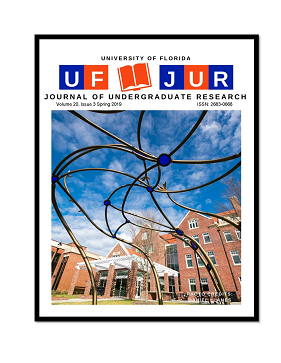Copper Indium Disulfide Quantum Dot Light Emitting Diodes for Display and Lighting Technologies
DOI:
https://doi.org/10.32473/ufjur.v20i3.106240Keywords:
Quantum Dots, LEDs, CIS,Abstract
While significant advances in the development of quantum dot light emitting diodes (QLEDs) have been reported, these devices are primarily based on cadmium chalcogenide quantum dot (QD) materials. Both environmental and health concerns arise due to the toxicity of cadmium and consequently, alternative less toxic QDs must be developed for large scale QLED applications such as display and solid state lighting technologies. In this work, copper indium disulfide (CIS) was investigated as an alternative QD material for QLED applications. Through experimentation with material synthesis and device fabrication, this project aimed to develop high performing CIS QLEDs. Several synthetic approaches were experimented with and it was determined that the injection of shorter chain 1-octanethoil as sulfur precursor with extensive shell reaction time resulted in highly luminescent QDs. Single color QLEDs were fabricated based on typical device structure, using highly luminescent synthesized CIS QDs as the emissive layer in multilayer devices. Varying the shell reaction time of QDs in order to vary shell thickness resulted in significant differences in device performance. Using thicker shell QDs, high performing devices were obtained with the best performing QLEDs displaying a high peak current efficiency of 14.7 cd/A and high external quantum efficiency of 5.2%.
Metrics
References
K. Yu, P. Ng, J. Ouyang, M. Zaman, A. Abulrob, T. Baral, D. Fatehi, Z. Jakubek, D. Kingston, X. Wu, X. Liu, C. Hebert, D. Leek and D. Whitfield, "Low-Temperature Approach to Highly Emissive Copper Indium Sulfide Colloidal Nanocrystals and Their Bioimaging Applications", ACS Applied Materials & Interfaces, vol. 5, no. 8, pp. 2870-2880, 2013.
L. Shi, V. De Paoli, N. Rosenzweig and Z. Rosenzweig, "Synthesis and Application of Quantum Dots FRET-Based Protease Sensors", Journal of the American Chemical Society, vol. 128, no. 32, pp. 10378-10379, 2006.
J. Lott, N. Ledentsov, V. Ustinov, A. Egorov, A. Zhukov, P. Kop'ev, Z. Alferov and D. Bimberg, "Vertical cavity lasers based on vertically coupled quantum dots", Electronics Letters, vol. 33, no. 13, p. 1150, 1997.
H. Shen, W. Cao, N. Shewmon, C. Yang, L. Li and J. Xue, "High-Efficiency, Low Turn-on Voltage Blue-Violet Quantum-Dot-Based Light-Emitting Diodes", Nano Letters, vol. 15, no. 2, pp. 1211-1216, 2015.
D. Vasudevan, R. Gaddam, A. Trinchi and I. Cole, "Core-shell quantum dots: Properties and applications", Journal of Alloys and Compounds, vol. 636, pp. 395-404, 2015.
Y. Shang and Z. Ning, "Colloidal quantum dots surface and device structure engineering for high performance light emitting diodes", National Science Review, p. nww097, 2017.
V. Singh, V. Ranjan and M. Kapoor, "Semiconductor quantum dots: Theory and phenomenology", Bulletin of Materials Science, vol. 22, no. 3, pp. 563-569, 1999.
S. Pokutnyi, "Theory of Excitons and Excitonic Quasimolecules Formed from Spatially Separated Electrons and Holes in Quasi - Zero - Dimensional Nanosystems", Optics, vol. 3, no. 6, p. 10, 2014.
D. Broido, A. Cros and U. Rössler, "Theory of holes in quantum dots", Physical Review B, vol. 45, no. 19, pp. 11395-11398, 1992.
Y. Shirasaki, G. Supran, M. Bawendi and V. Bulović, "Emergence of colloidal quantum-dot light-emitting technologies", Nature Photonics, vol. 7, no. 1, pp. 13-23, 2013.
V. Colvin, M. Schlamp and A. Alivisatos, "Light-emitting diodes made from cadmium selenide nanocrystals and a semiconducting polymer", Nature, vol. 370, no. 6488, pp. 354-357, 1994.
G. Supran, Y. Shirasaki, K. Song, J. Caruge, P. Kazlas, S. Coe-Sullivan, T. Andrew, M. Bawendi and V. Bulović, "QLEDs for displays and solid-state lighting", MRS Bulletin, vol. 38, no. 09, pp. 703-711, 2013.
I. Ugarte, I. Castell, E. Palomares and R. Pacios, "Quantum Dots as a Light Indicator for Emitting Diodes and Biological Coding", Quantum Dots - A Variety of New Applications, 2012.
H. Zhang, X. Sun and S. Chen, "Over 100 cd A−1 Efficient Quantum Dot Light-Emitting Diodes with Inverted Tandem Structure", Advanced Functional Materials, vol. 27, no. 21, p. 1700610, 2017.
"Compliance FAQs: RoHS", NIST, 2018. [Online]. Available: https://www.nist.gov/standardsgov/compliance-faqs-rohs. [Accessed: 11- Apr- 2018].
A. Leach and J. Macdonald, "Optoelectronic Properties of CuInS2 Nanocrystals and Their Origin", The Journal of Physical Chemistry Letters, vol. 7, no. 3, pp. 572-583, 2016.
A. Williams, S. Winfield and J. Miller, "Relative fluorescence quantum yields using a computer-controlled luminescence spectrometer", The Analyst, vol. 108, no. 1290, p. 1067, 1983.
J. Kim and H. Yang, "High-Efficiency Cu-In-S Quantum-Dot-Light-Emitting Device Exceeding 7%", Chemistry of Materials, vol. 28, no. 17, pp. 6329-6335, 2016.
P. Chuang, C. Lin and R. Liu, "Emission-Tunable CuInS2/ZnS Quantum Dots: Structure, Optical Properties, and Application in White Light-Emitting Diodes with High Color Rendering Index", ACS Applied Materials & Interfaces, vol. 6, no. 17, pp. 15379-15387, 2014.
L. De Trizio, M. Prato, A. Genovese, A. Casu, M. Povia, R. Simonutti, M. Alcocer, C. D'Andrea, F. Tassone and L. Manna, "Strongly Fluorescent Quaternary Cu-In-Zn-S Nanocrystals Prepared from Cu1-xInS2 Nanocrystals by Partial Cation Exchange", Chemistry of Materials, vol. 24, no. 12, pp. 2400-2406, 2012.
Downloads
Published
Issue
Section
License
Some journals stipulate that submitted articles cannot be under consideration for publication or published in another journal. The student-author and mentor have the option of determining which journal the paper will be submitted to first. UF JUR accepts papers that have been published in other journals or might be published in the future. It is the responsibility of the student-author and mentor to determine whether another journal will accept a paper that has been published in UF JUR.

